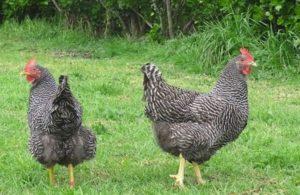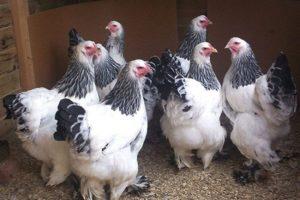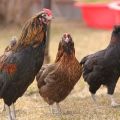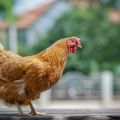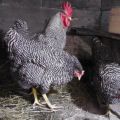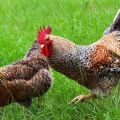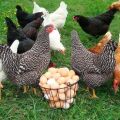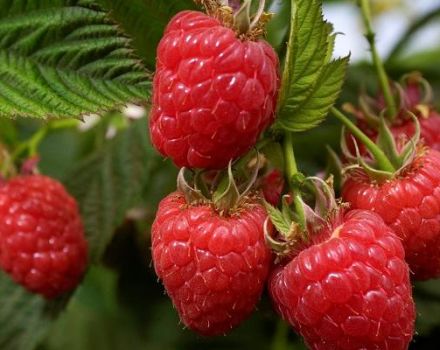Characteristics and description of the Pushkinskaya chicken breed, maintenance rules
Pushkin chickens are a breed that is popular among farmers due to their unpretentious care, productive egg production and high-quality meat. This breed will serve as an excellent choice - both for a large poultry farm and for a private farm. Let's look at the advantages and disadvantages of Pushkin chickens and figure out how to properly care for and breed them.
History of the origin of the breed
The Pushkin breed was bred in the second half of the twentieth century in the city of Pushkin, Leningrad Region. The main goal pursued by the breeders was the creation of a classic village chicken, capable, with minimal care, of producing a large number of eggs and tasty meat. For breeding, variegated and black Australorpus were crossed with Leghorns.
Initially bred specimens of chickens showed low productivity until the breeders crossed the breed with the Russian breed Broiler-6. The result is robust striped-and-white hens that regularly lay eggs.
Appearance, standards and varieties
Pushkin chickens are characterized by the presence of long legs and important posture due to the erect tail. The bird's head is long, with protruding eyes and a pink comb. The beak is bent down. The wings are fluffy. The bird's body itself is large, strong. Chickens are characterized by a gray color interspersed with white, while in roosters, on the contrary, white color with rare gray spots dominates.
Petersburg line
Females of the St. Petersburg line have a two-kilogram weight, males weigh up to three kilograms. One laying hen produces more than two hundred eggs per year. Eggs weigh up to sixty grams. Cocks of the St. Petersburg line are characterized by a much lighter color than hens, so they are easy to distinguish from each other.
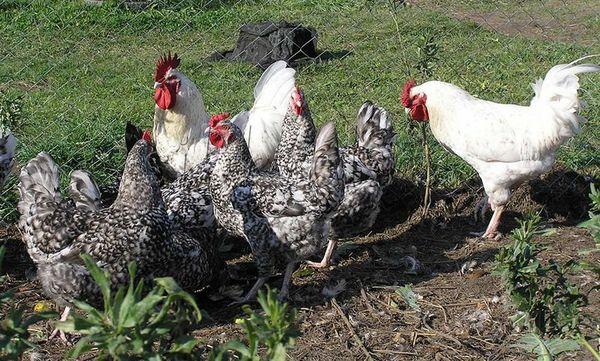
Moscow line
Males of the Moscow line are distinguished by much more colorful plumage than the representatives of the St. Petersburg line. However, the roosters of the Moscow line are still lighter than hens, so they are also not easy to confuse.
Advantages and disadvantages
Farmers love the breed for its many benefits. The main advantages of birds are:
- adaptability to various temperature conditions, both in adult representatives and in chickens;
- unassuming to feed;
- frequent egg-laying and quality meat;
- a large percentage of egg fertilization and chick survival;
- immunity to disease.
The disadvantage of Pushkin chickens is that they are inactive and cannot run, which can negatively affect the chicken's body.

Productivity and egg production
Pushkin chickens are fruitful in terms of carrying eggs, and their meat is of high quality and excellent taste.
Meat
Pushkin chickens are birds with massive dimensions. The female reaches a weight of two kilograms, the male grows up to three kilograms. The carcass lends itself well to plucking. Bird skin is durable. The meat itself has excellent taste and is suitable for making broth.
Eggs
Oviposition in females begins already in the sixth-seventh month. Pushkin chickens demonstrate one of the highest egg laying rates, second only to egg breeds.
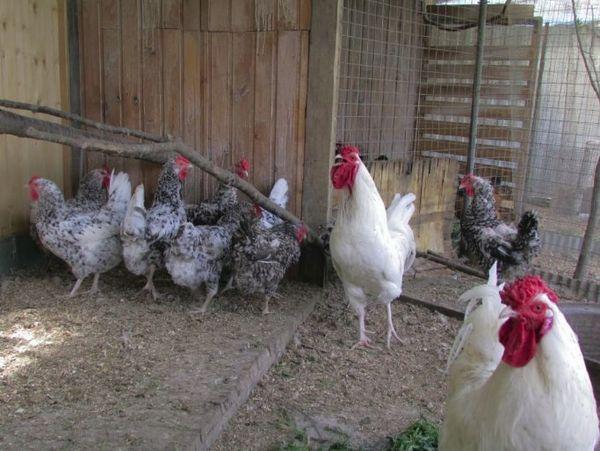
One adult bird produces more than two hundred eggs annually, and with the right temperature conditions, the right food and lighting, the hen will produce up to three hundred eggs a year. They lay even in winter, and in summer they give eggs almost every day, with the exception of the molting period.
In the first months, a sexually mature laying hen produces eggs weighing up to fifty grams, and after a year of life, the eggs begin to reach seventy grams. The eggs themselves have a dense white, the yolk is bright yellow.
Keeping chickens
The Pushkin breed is undemanding to keeping conditions. The main thing is to give the birds a warm place to sleep and winter. An insulated barn is not required, but it is important that the room is protected from drafts.
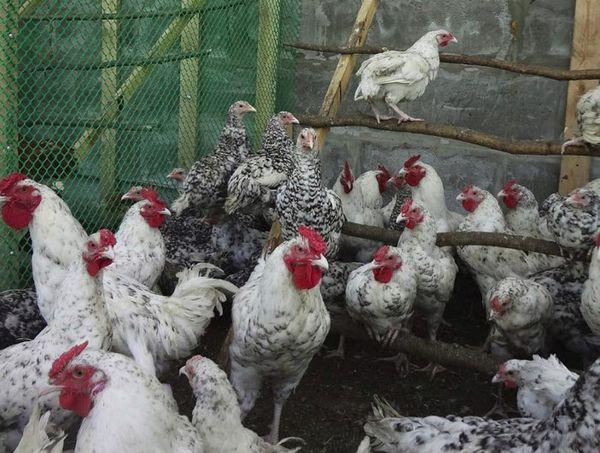
Chicken coop
The room should be equipped with a warm mat. Chickens can also be kept on regular perches. They should be positioned at a height of approximately 0.8 meters and equipped with a ladder for lifting.
To lay eggs, you need to equip separate special boxes, covered with warm straw. Sawdust is not suitable as a bedding material, since chickens love to dig in them, so the sawdust will be quickly thrown away. You shouldn't put them on the floor of the shed either, the birds will rummage in them and unearth them, no matter how tightly they are rammed. In addition, sawdust will enter the airways of chickens, provoking lung disease.
Courtyard
Although initially the breed was declared by breeders as flightless, this trait could not be fixed. Modern representatives can easily fly over a fence one and a half meters high. Therefore, the yard for walking chickens must be covered. Such an aviary, among other things, will protect birds from predators, since Pushkin chickens are slow, cannot run and do not have time to react to a sudden approach of danger.
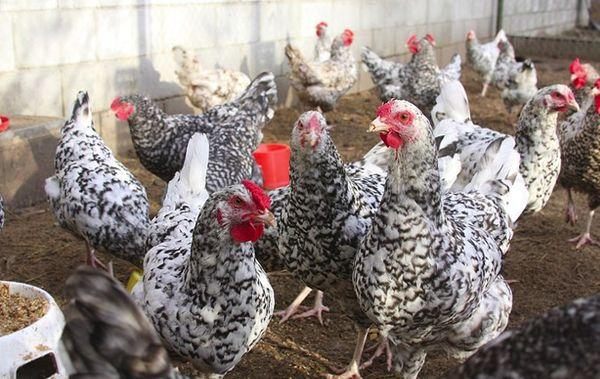
Drinking bowls and feeders
The size of the feeder depends on the number of chickens you breed and the size of the coop. If you plan to breed birds during the winter, place the feeder inside the chicken coop. Chickens need both dry food and wet food, so you need to equip feeders for both types of food. Hopper-type feeders are suitable for dry feed, open troughs for wet mash.
Structures must be stable and durable. Chickens are constantly pushing the feeders, so the feed should not spill through them - this entails unnecessary feed consumption and a violation of sanitation. Feeders should be cleaned and refilled regularly.
How to heat a chicken coop in winter?
Poultry does not tolerate cold temperatures in the best way, therefore, when keeping chickens, one cannot do without heating in the chicken coop. In most cases, artificial heating is the only way to provide the birds with optimal conditions.
The exceptions are temperate climates and warmer climatic zones - here, as a rule, natural heating is sufficient.
The safest and most economical way to heat a room is to use electric heaters.Air heaters, oil heaters, electric convectors, ceramic panels, infrared heaters are suitable.

An alternative can be gas and furnace heating systems. Each of the methods has its own advantages, disadvantages and conditions for correct use, but, in any case, such space heating will help to cope with sharp drops in temperature.
Bird diet
The egg production and quality of chicken meat depends, first of all, on a properly composed diet. For this breed, the usual diet for laying hens is suitable.
Chicks
After birth, young chicks first consume the internal embryonic clot for food. Two hours after hatching, the chicks should be fed with boiled dry millet. This will allow the chicks to open their beak so that they do not choke in the future.

The first days of the chicken should be fed with boiled yolk. Subsequently, animal food is excluded from the diet. Chicks need fresh water and greens. You can add a small amount of milk to the feeder.
For the first ten days of life, the chick should be fed every three hours. After a week of age, chicks can be fed with potatoes, grated carrots. From the tenth day, chalk should be included in the diet. Chicks older than a month willingly eat mixed feed, chopped greens, various mash.
Be sure to grind large vegetables. Change the water in the drinker every four hours.
Adults
Adult chickens are fed with grain, compound feed, herbs. The food must be fresh. Feeding twice a day is optimal. Different types of grains should not be mixed with each other; they should be given to the birds in turn. Chickens need to be walked regularly.
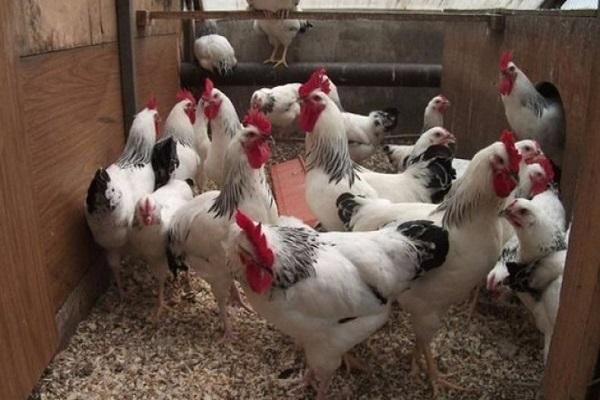
In the diet of chickens, fine gravel must be present. It will grind food in the bird's body. Containers with gravel should be in places easily accessible to chickens. Also, in order to avoid biting the shell of eggs, chickens should be given calcium-containing foods. For males, as an addition to the diet, preparations containing vitamin A are suitable.
Breeding rules
Determining the sex of the nestlings of the Pushkin breed, as a rule, is not difficult. It is best to purchase adult birds of both sexes. Several adult pairs and a couple of small chicks can be purchased. Poultry should be bought at the factory, as when buying from hands there is a risk of unhealthy chickens.
Factories, as a rule, provide certificates that chickens have received quality genes and do not have diseases. Bird prices vary depending on whether you buy a hen, a rooster or a chick.
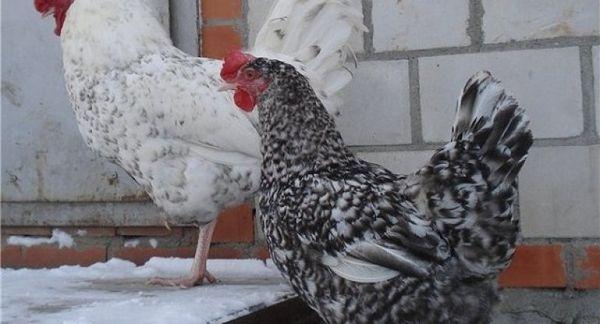
The most important thing in keeping Pushkin's hands is to provide them with a warm enough place to live. The coop must be well protected from drafts and excessive moisture. In the summer, it is better to keep the birds outdoors, not forgetting the need for an indoor aviary.
Diseases and their treatment
Despite the high immunity of chickens to disease, farmers should screen birds for disease. Pushkin chickens are susceptible to plague, psittacosis, paratyphoid fever, pullorosis, eimeriosis. These diseases are infectious, and one affected bird can infect an entire chicken coop.
Often, birds are affected by parasitic diseases, for example, rickets and prostogonymia. A sick chicken is often difficult to distinguish from a healthy chicken, therefore, if any symptoms appear, you should immediately contact your veterinarian.
